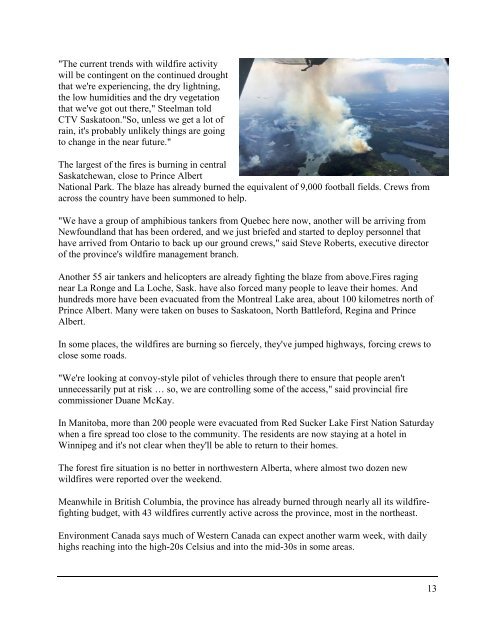Culmiating Task-3.pdf
- No tags were found...
You also want an ePaper? Increase the reach of your titles
YUMPU automatically turns print PDFs into web optimized ePapers that Google loves.
"The current trends with wildfire activitywill be contingent on the continued droughtthat we're experiencing, the dry lightning,the low humidities and the dry vegetationthat we've got out there," Steelman toldCTV Saskatoon."So, unless we get a lot ofrain, it's probably unlikely things are goingto change in the near future."The largest of the fires is burning in centralSaskatchewan, close to Prince AlbertNational Park. The blaze has already burned the equivalent of 9,000 football fields. Crews fromacross the country have been summoned to help."We have a group of amphibious tankers from Quebec here now, another will be arriving fromNewfoundland that has been ordered, and we just briefed and started to deploy personnel thathave arrived from Ontario to back up our ground crews," said Steve Roberts, executive directorof the province's wildfire management branch.Another 55 air tankers and helicopters are already fighting the blaze from above.Fires ragingnear La Ronge and La Loche, Sask. have also forced many people to leave their homes. Andhundreds more have been evacuated from the Montreal Lake area, about 100 kilometres north ofPrince Albert. Many were taken on buses to Saskatoon, North Battleford, Regina and PrinceAlbert.In some places, the wildfires are burning so fiercely, they've jumped highways, forcing crews toclose some roads."We're looking at convoy-style pilot of vehicles through there to ensure that people aren'tunnecessarily put at risk … so, we are controlling some of the access," said provincial firecommissioner Duane McKay.In Manitoba, more than 200 people were evacuated from Red Sucker Lake First Nation Saturdaywhen a fire spread too close to the community. The residents are now staying at a hotel inWinnipeg and it's not clear when they'll be able to return to their homes.The forest fire situation is no better in northwestern Alberta, where almost two dozen newwildfires were reported over the weekend.Meanwhile in British Columbia, the province has already burned through nearly all its wildfirefightingbudget, with 43 wildfires currently active across the province, most in the northeast.Environment Canada says much of Western Canada can expect another warm week, with dailyhighs reaching into the high-20s Celsius and into the mid-30s in some areas.13


